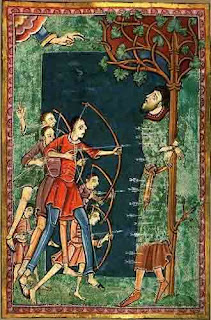
Shortly after dawn on 29 November 1864, Colonel John Milton Chivington of the Third Colorado Calvalry led his troops in concert with the First Colorado Calvary and the First New Mexico Volunteers against an encampment of Southern Cheyenne and Arapaho Indians along Sand Creek, near Ft. Lyon, Colorado. In one of the most horrific massacres in United States history, Chivington presided over the killing and mutilation of nearly two hundred people, the vast majority of whom were women and children under the protection of Black Kettle, one of the Cheyenne "peace chiefs" who had agreed two months before to relocate his people to Indian Territory.
Chivington, an anti-slavery Methodist minister prior to the Civil War, insisted that the Cheyenne and Arapaho were deserving of their fate because they were "hostile to whites." Pointing to a cluster of notorious murders and attacks against white settlers the previous summer, as well as the looting of property which he calculated at a value of $300,000, Chivington claimed that he "had every reason to believe that these Indians were either directly or indirectly concerned in the outrages." Although it was well known at the time that the Indians under Black Kettle were not responsible for the attacks, Chivington was committed to the principle of collective punishment. As he later explained to Congress, the "character of Indians in the western country for truth and veracity, like their respect for the chastity of women who may become prisoners in their hands, is not of that order which is calculated to inspire confidence in what they may say."
Defending truth and chastity -- to say nothing of the mining interests that were anticipating the clearance of Indians from the region -- Chivington's troops descended upon the Sand Creek encampment, stiff with drink and eager to shed their nickname of the "Bloodless Third." Reminding his men that "nits make lice," Chivington ordered his soldiers to spare no one and burn what they chose not to plunder.
John S. Smith, a federal Indian agent and interpreter from Ft. Lyon, witnessed the slaughter and offered his testimony to Congress in 1865
[A]bout a mile above the village, the troops had got a parcel of the Indians hemmed in under the bank of the river; as soon as the troops overtook them, they commenced firing on them; some troops had got above them, so that they were completely surrounded. There were probably a hundred Indians hemmed in there, men, women, and children; the most of the men in the village escaped.
By the time I got up with the battery to the place where these Indians were surrounded there had been some considerable firing. Four or five soldiers had been killed, some with arrows and some with bullets. The soldiers continued firing on these Indians, who numbered about a hundred, until they had almost completely destroyed them. I think I saw altogether some seventy dead bodies lying there; the greater portion women and children. There may have been thirty warriors, old and young; the rest were women and small children of different ages and sizes.
Similar atrocities marked the rest of the day. Afterwards, soldiers mutilated the bodies of the dead, scapling and dismembering them while looting and burning their possessions; Chivington himself appeared at a Denver theater several days later, toting a chain of 100 scalps and the genitalia a Cheyenne woman. Some reports suggested that Chivington also brought a fetus.
Initially celebrated as a heroic victory, the inaptly named "Battle of Sand Creek" soon proved to be a national disgrace. Two Congressional inquiries later condemned Chivington, although a general amnesty granted to soldiers after the Civil War spared him from prosecution. His military career in shambles and his ample political ambitions thwarted, Chivington lived with the memories of Sand Creek for nearly thirty more years, during which time he provided little evidence of the psychological torment he most assuredly deserved. He died -- one hopes quite painfully -- of cancer in 1892.
A railroad town named for the colonel in 1887 was abandoned during the Dust Bowl of the 1920s. Its remains are slowly being overtaken by prairie grass.
This is a re-post of last year's entry
Labels: american indians, massacres
 Robert Craig Knievel, Jr.
Robert Craig Knievel, Jr.















